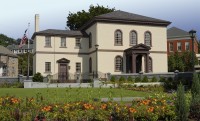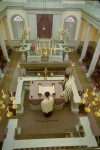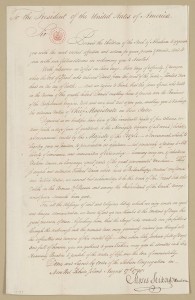 Yesterday the Touro Synagogue in Newport, Rhode Island, blew out 250 candles on its metaphoric cake. Built between 1759 and 1763 by English architect Peter Harrison, it was the second synagogue constructed in what would become the United States. The first was built in 1730 for the Congregation Shearith Israel on Mill Street in lower Manhattan, but that was demolished in 1818 to make room for a larger synagogue on the same spot leaving the Touro Synagogue the oldest synagogue in the country. It is now the only surviving synagogue from the colonial era.
Yesterday the Touro Synagogue in Newport, Rhode Island, blew out 250 candles on its metaphoric cake. Built between 1759 and 1763 by English architect Peter Harrison, it was the second synagogue constructed in what would become the United States. The first was built in 1730 for the Congregation Shearith Israel on Mill Street in lower Manhattan, but that was demolished in 1818 to make room for a larger synagogue on the same spot leaving the Touro Synagogue the oldest synagogue in the country. It is now the only surviving synagogue from the colonial era.
Newport had had a small but vibrant Jewish community since the first 15 families arrived from Barbados in 1658. These were Spanish and Portuguese Jews, a subset of Sephardic Jews descended from conversos, forced converts to Christianity under the Inquisition who reverted to their ancestral Judaism when they left Spain and Portugal for more tolerant pastures, including colonies in South America and the West Indies. The Shearith Israel congregation was established in New Amsterdam against the strident wishes of Governor Peter Stuyvesant thanks to the intervention of Jewish directors of the Dutch West India Company, while Jews were banned from British North America as they had been in all British territory since King Edward I’s Edict of Expulsion in 1290. It was Oliver Cromwell who, in exchange for financing, let them come back almost 400 years later in 1657. That opened the door in the colonies as well, and the Newport Jews were the first to walk through.
They still had to deal with colonial laws that prohibited them from public worship, from holding office and from voting. The Jewish congregations in New York and Rhode Island used their private homes as synagogues for decades until in the laws changed in the first half of the 18th century. The Shearith Israel synagogue was built at the first opportunity to attend to the spiritual needs of the relatively large Manhattan congregation. The smaller Congregation Yeshuat Israel in Newport reached a critical mass of about 70 congregants three decades later and what is now known as the Touro Synagogue was built.
 Peter Harrison was a self-taught architect who is known for being the first to introduce Palladian design to colonial America. The elegant exterior of the Newport synagogue has Palladian elements while for the interior he relied on the memory of cantor Isaac Touro, a recent arrival from Amsterdam via the West Indies. He described to Harrison the Sephardic synagogues he had known in Amsterdam and they informed the architects’ design. The Yeshuat Israel synagogue was dedicated during Chanukah celebrations on December 2nd, 1763.
Peter Harrison was a self-taught architect who is known for being the first to introduce Palladian design to colonial America. The elegant exterior of the Newport synagogue has Palladian elements while for the interior he relied on the memory of cantor Isaac Touro, a recent arrival from Amsterdam via the West Indies. He described to Harrison the Sephardic synagogues he had known in Amsterdam and they informed the architects’ design. The Yeshuat Israel synagogue was dedicated during Chanukah celebrations on December 2nd, 1763.
On the eve of the Revolution, there were an estimated 1,175 Jews in Newport, 300 of them regular attendants at the synagogue. Newport was hard hit by the onset of hostilities. The English took the city in the fall of 1776, confiscating patriot ships, buildings and businesses. Many pro-Independence residents fled to Massachusetts and elsewhere. A few stayed behind at great risk to themselves, among them Isaac Touro and Moses Seixas, an ardent patriot and the founder of the King David Masonic Lodge in Newport, the oldest Jewish lodge in the country. They kept watch over the synagogue which had been commandeered by the British for use as a hospital and public assembly hall. Its usefulness is what kept it intact even as the British demolished a great many colonial Newport structures to burn their wood during the winter.
The British left Newport in 1779 and the ousted patriots began to return to put their homes and businesses back together. In September of 1780, the first post-occupation General Assembly of the State of Rhode Island convened in the synagogue. Ten years later on August 17-18th, 1790, the Congregation Yeshuat Israel played host to President George Washington, Secretary of State Thomas Jefferson, Governor George Clinton of New York, U.S. Supreme Court Justice John Blair of Virginia, and U.S. Congressman William Loughton Smith of South Carolina. Rhode Island had a long tradition of religious tolerance going back to its founder Roger Williams who was banished from Massachusetts for his heretical religious beliefs, so it was the last state to ratify the Constitution on May 29, 1790, and only did so after it was assured that a Bill of Rights would be added. Washington visited Newport, and very pointedly the synagogue, to rally support for the Bill of Rights which was still being debated in the legislatures of Virginia, Massachusetts, Connecticut and Georgia at the time.
 At the time of his visit, Moses Seixas was the president of the synagogue. As a fellow high-ranking mason, a civilian hero of the Revolution and the brother of Shearith Israel Congregation’s Rabbi Gershon Mendes Seixas, aka the “patriot rabbi” who was one of 14 religious leaders to officiate at Washington’s 1789 Inauguration, Moses was tasked with delivering a welcome address to the President. His eloquent words in favor of democracy and freedom of conscience and George Washington’s quotation of them in his response have gone down in history as a seminal exchange on the subject of religious freedom at the dawn of the United States.
At the time of his visit, Moses Seixas was the president of the synagogue. As a fellow high-ranking mason, a civilian hero of the Revolution and the brother of Shearith Israel Congregation’s Rabbi Gershon Mendes Seixas, aka the “patriot rabbi” who was one of 14 religious leaders to officiate at Washington’s 1789 Inauguration, Moses was tasked with delivering a welcome address to the President. His eloquent words in favor of democracy and freedom of conscience and George Washington’s quotation of them in his response have gone down in history as a seminal exchange on the subject of religious freedom at the dawn of the United States.
The key passage from the Seixas address:
Deprived as we heretofore have been of the invaluable rights of free Citizens, we now with a deep sense of gratitude to the Almighty disposer of all events behold a Government, erected by the Majesty of the People — a Government, which to bigotry gives no sanction, to persecution no assistance — but generously affording to all Liberty of conscience, and immunities of Citizenship: deeming every one, of whatever Nation, tongue, or language equal parts of the great governmental Machine[.]
On August 21nd, 1790, George Washington sent a letter to the Congregation Yeshuat Israel in response. The oft-quoted passage therefrom:
The citizens of the United States of America have a right to applaud themselves for having given to mankind examples of an enlarged and liberal policy—a policy worthy of imitation. All possess alike liberty of conscience and immunities of citizenship.
It is now no more that toleration is spoken of as if it were the indulgence of one class of people that another enjoyed the exercise of their inherent natural rights, for, happily, the Government of the United States, which gives to bigotry no sanction, to persecution no assistance, requires only that they who live under its protection should demean themselves as good citizens in giving it on all occasions their effectual support. […]
May the children of the stock of Abraham who dwell in this land continue to merit and enjoy the good will of the other inhabitants—while every one shall sit in safety under his own vine and fig tree and there shall be none to make him afraid.
Washington’s reply, in particular his repetition of Moses Seixas’ phrase, “to bigotry no sanction, to persecution no assistance,” has become emblematic of the new nation’s dedication to religious liberty and the separation of church and state. The original manuscript of the address is part of the George Washington Papers in the Library of Congress and the original Washington response belongs to Frederick Phillips of New York, but so important is this exchange that even contemporary newspaper print versions are incredibly valuable. The address and letter were printed in the Gazette of the United States, an early Federal newspaper in Philadelphia, on September 15th, 1790. That page and another from the September 11th, 1790, issue that describes the President’s visit to Newport are going on sale at a Bonhams’ Judaica auction on December 10th. The pre-sale estimate is $80,000 – $100,000.
 The Congregation Yeshuat Israel synagogue went through some hard times after Washington’s visit. In 1791 regular services stopped as the once bustling commercial life of Newport slumped and much of the merchant class moved to New York. The Jewish community was reduced to a few longtime residents and regular visitors who returned to attend an occasional holy day service or funeral. The cemetery continued to be used as former residents often asked to be buried in the traditional cemetery of their fathers. It was the Touro family, Isaac’s sons Abraham and Judah, who donated money to fund maintenance on the synagogue and cemetery in their old hometown. In the first half of the 19th century, they both made substantial bequests to the state of Rhode Island for the perpetual care of the Congregation properties. That’s when the synagogue became known as the Touro Synagogue
The Congregation Yeshuat Israel synagogue went through some hard times after Washington’s visit. In 1791 regular services stopped as the once bustling commercial life of Newport slumped and much of the merchant class moved to New York. The Jewish community was reduced to a few longtime residents and regular visitors who returned to attend an occasional holy day service or funeral. The cemetery continued to be used as former residents often asked to be buried in the traditional cemetery of their fathers. It was the Touro family, Isaac’s sons Abraham and Judah, who donated money to fund maintenance on the synagogue and cemetery in their old hometown. In the first half of the 19th century, they both made substantial bequests to the state of Rhode Island for the perpetual care of the Congregation properties. That’s when the synagogue became known as the Touro Synagogue
It wasn’t until the population of Jews in Newport was boosted by Eastern European immigrants in 1883 that the synagogue reopened for regular worship again. Although the Jewish population of Newport is small today — an estimated 200 people — the synagogue’s commitment to its rich history is unflagging and it is visited by thousands of tourists a year. The synagogue holds an annual public reading of George Washington’s famous letter that is so popular you have to make reservations to attend. This year the keynote speaker was Supreme Court Justice Elena Kagan who said: “In the early years of the Republic, every word George Washington said was addressed to the larger country, and every aspect of that lesson resonates today as strongly as it did in 1790.”
Newport certainly did gain a vibrant Jewish community, once the first families arrived from Barbados in 1658. Clearly they were Spanish and Portuguese Jews who made a new and safer life in the colonies in South America and the West Indies.
So we should look at the beautiful architecture of Touro (1759-63), and compare it to synagogues in the communities these families came from. Where did the architect Peter Harrison take his inspiration from?
Many thanks for the links
Hels
Art and Architecture, mainly
http://melbourneblogger.blogspot.com.au/2010/06/caribbean-jewish-communities.html and
http://melbourneblogger.blogspot.com.au/2010/09/jewish-dutch-architecture-in-suriname.html
This synagogue looks astonishingly like the Congregational Church I attended when I was growing up, especially the columns and the brass chandeliers, and the arrangement of the bema seat. Thank you for posting this very relevant and important account for us.
I’m a former member of Kings Chapel in Boston, one of Harrison’s other architectural delight. Ironic isn’t it, that Harrison’s buildings are home to both the oldest synagogue and the birthplace of the Unitarianism in the US.
I think Shearith Israel, Spanish and Portuguese synagogue, nyc, is older..1625 🙂
Shearith Israel’s congregation dates to the 1600s, but not the synagogue. As I noted above, there were colonial laws against public worship that prohibited the construction of synagogues. Services were held in people’s homes.
The first Shearith Israel synagogue was built in 1730. That would make it the oldest in the country, but the original building was destroyed in 1818 and a new, larger synagogue built on the site.
:yes: this helps put together the pieces of USA’s history concerning George Washington and his support of our Jewish people and the Jewish people’s financial support given to George Washington. He needed money when he ran and became the first president of our United States of America.
Thank you for sharing! INA G.